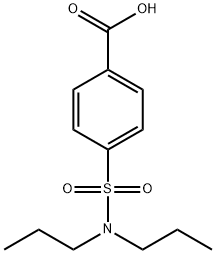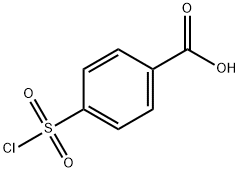Probenecid
- CAS No.
- 57-66-9
- Chemical Name:
- Probenecid
- Synonyms
- 4-(N,N-Dipropylsulfamoyl)benzoic acid;PROBENICID;Binghuangshu;4-(Dipropylsulfamoyl)benzoic acid;4-((dipropylamino)sulfonyl)-benzoicaci;4-[(dipropylamino)sulphonyl]benzoic acid;Apurina;benacen;Benemid;probalan
- CBNumber:
- CB9134579
- Molecular Formula:
- C13H19NO4S
- Molecular Weight:
- 285.36
- MDL Number:
- MFCD00038402
- MOL File:
- 57-66-9.mol
- MSDS File:
- SDS
| Melting point | 194-196°C |
|---|---|
| Boiling point | 438.0±47.0 °C(Predicted) |
| Density | 1.2483 (rough estimate) |
| refractive index | 1.6800 (estimate) |
| storage temp. | Store at RT |
| solubility | DMSO (Slightly), Methanol (Slightly) |
| pka | 5.8(at 25℃) |
| color | White to Off-White |
| Water Solubility | <0.1 g/100 mL at 20 ºC |
| Merck | 14,7754 |
| Stability | Stable, but may be light sensitive. Incompatible with strong oxidizing agents. |
| CAS DataBase Reference | 57-66-9(CAS DataBase Reference) |
| EWG's Food Scores | 1 |
| NCI Dictionary of Cancer Terms | probenecid |
| FDA UNII | PO572Z7917 |
| NIST Chemistry Reference | P-(dipropylsulfamoyl) benzoic acid(57-66-9) |
| NCI Drug Dictionary | Benemid |
| ATC code | M04AB01 |
| EPA Substance Registry System | Probenecid (57-66-9) |
SAFETY
Risk and Safety Statements
| Symbol(GHS) |  GHS07 |
|||||||||
|---|---|---|---|---|---|---|---|---|---|---|
| Signal word | Warning | |||||||||
| Hazard statements | H302 | |||||||||
| Precautionary statements | P301+P312+P330 | |||||||||
| Hazard Codes | Xn | |||||||||
| Risk Statements | 22-40 | |||||||||
| Safety Statements | 36/37-24/25 | |||||||||
| RIDADR | 3249 | |||||||||
| WGK Germany | 3 | |||||||||
| RTECS | DG9400000 | |||||||||
| TSCA | Yes | |||||||||
| HS Code | 29350090 | |||||||||
| NFPA 704 |
|
Probenecid price More Price(31)
| Manufacturer | Product number | Product description | CAS number | Packaging | Price | Updated | Buy |
|---|---|---|---|---|---|---|---|
| Sigma-Aldrich | P8761 | Probenecid | 57-66-9 | 25g | $111 | 2024-03-01 | Buy |
| Sigma-Aldrich | PHR2608 | Probenecid | 57-66-9 | 500MG | $173 | 2024-03-01 | Buy |
| Sigma-Aldrich | 1563003 | Probenecid United States Pharmacopeia (USP) Reference Standard | 57-66-9 | 200mg | $261.6 | 2024-03-01 | Buy |
| Alfa Aesar | B20010 | Probenecid, 98% | 57-66-9 | 2.5g | $52.1 | 2021-12-16 | Buy |
| Cayman Chemical | 14981 | Probenecid ≥98% | 57-66-9 | 5g | $32 | 2024-03-01 | Buy |
Probenecid Chemical Properties,Uses,Production
Anti-gout drug
Probenecid is a chemically synthetic sulfa anti-gout drug, also known as oxybenzone sulfonamides, which has dual role of both promoting the excretion of uric acid excretion and inhibiting the excretion of penicillin. Clinically it is used for treating chronic gout and suppressing excretion of penicillin-type drugs in order to increase their clinical plasma concentration as an adjuvant drug of penicillin therapy. Its mechanism of action is inhibiting the re-absorption of renal tubular on uric acid, thus increasing uric acid excretion and further lowering plasma uric acid concentration for reducing the deposition of urate in tissues and prevent the crystallization of urate. This product can also promote the dissolution of the pre-formed urate, thereby reducing its damage on the joint. In addition, the product can also competitively inhibit the secretion of a weak organic acid (such as penicillin, cephalosporins) in the renal tubules, which can increase blood concentrations of these antibiotics and prolong their duration of action. This product is easy for oral administration with a plasma protein binding rate of 85% to 90%. Adults take 1 g orally each time with the plasma concentration reaches peak after 2~4 hour and with a half-life of being 6 to 12 hours. Probenecid is rapidly metabolized in the liver with the major metabolite being probenecid acetyl glucuronic acid. The main metabolite is excreted through the urine. This product has no anti-inflammatory and analgesic effect, and thus being invalid for treating acute gout. Acute toxicity test results: orally: LD50 of rats being 1600mg/kg. After the oral administration, the major adverse reactions are gastrointestinal reactions with others adverse reactions including dizziness, headache, facial flushing, urinary frequency, gingival swelling and pain, skin rash; there are also occasional allergic reactions. It is not suitable for being applied to patients of acute gout and with history of uric acid crystal deposition in kidney and ureter. Patients of peptic ulcer or blood abnormalities and pregnant women should take with caution. Patients of renal dysfunction are not allowed for using it.
clinical pharmacology
Probenecid is a uricosuric and renal tubular blocking agent. It inhibits the tubular reabsorption of urate, thus increasing the urinary excretion of uric acid and decreasing serum urate levels. Effective uricosuria reduces the miscible urate pool, retards urate deposition, and promotes resorption of urate deposits.
Probenecid inhibits the tubular secretion of penicillin and usually increases penicillin plasma levels by any route the antibiotic is given. A 2-fold to 4-fold elevation has been demonstrated for various penicillins.
Probenecid also has been reported to inhibit the renal transport of many other compounds including aminohippuric acid (PAH), aminosalicylic acid (PAS), indomethacin, sodium iodomethamate and related iodinated organic acids, 17 –ketosteroids, pantothenic acid, phenolsulfonphthalein (PSP), sulfonamides, and sulfonylureas. See also Drug Interactions.
Probenecid decreases both hepatic and renal excretion of sulfobromophtalein (BSP). The tubular reabsorption of phosphorus is inhibited in hypoparathyroid but not in euparathyroid individuals.
Probenecid does not influence plasma concentrations of salicylates, nor the excretion of streptomycin, chloramphenicol, chlortetracycline, oxytetracycline, or neomycin.
Indications
1. For treating hyperuricemia with chronic gouty arthritis and tophi, take 2 times per day for adults with the dose of each time being 25 mg, increase the dose to 2 times per day after 1 week with 500 mg each time. Upon the administration, maintain the daily intake of water being at 2500mL to prevent the formation of kidney stones, simultaneously take alkaline urine drug if necessary. But make sure that: 1, the filtration rate of glomerular should be greater than 50~60mL/min; 2, no kidney stones or history of kidney stones; 3, non-acidic urine; 4, patients of non-taking salicylates; 5, have regular tests of blood and urine pH value, liver and kidney function as well as the uric acid levels in blood and urine; 6, adjust the dose according to the clinical and uric acid level and maintain for a long time with the minimum effective amount.
2. As an adjunct drug for antibiotic treatment; it can be combined together with different antibiotics such as penicillin, ampicillin, oxacillin, amoxicillin ortho chlorine, and nafcillin; Probenecid can be used for inhibiting the discharge of these antibiotics, increase their blood concentration and can maintain for a relative long time.
The above information is edited by the Chemicalbook of Dai Xiongfeng.
Drug Interactions
When probenecid is used to elevate plasma concentrations of penicillin or other beta-lactams, or when such drugs are given to patients taking probenecid therapeutically, high plasma concentrations of the other drug may increase the incidence of adverse reactions associated with that drug. In the case of penicillin or other beta-lactams, psychic disturbances have been reported.
The use of salicylates antagonizes the uricosuric action of probenecid (see WARNINGS). The uricosuric action of probenecid is also antagonized by pyrazinamide.
Probenecid produces an insignificant increase in free sulfonamide plasma concentrations, but a significant increase in total sulfonamide plasma levels. Since probenecid decreases the renal excretion of conjugated sulfonamides, plasma concentrations of the latter should be determined from time to time when sulfonamide and probenecid are coadministered for prolonged periods. Probenecid may prolong or enhance the action of oral sulfonylureas and thereby increase the risk of hypoglycemia.
It has been reported that patients receiving probenecid require significantly less thiopental for induction of anesthesia. In addition, ketamine and thiopental anesthesia were significantly prolonged in rats receiving probenecid.
The concomitant administration of probenecid increases the mean plasma elimination half-life of a number of drugs which can lead to increased plasma concentrations. These include agents such as indomethacin, acetaminophen, naproxen, ketoprofen, meclofenamate, lorazepam, and rifampin. Although the clinical significance of this observation has not been established, a lower dosage of the drug may be required to produce a therapeutic effect, and increases a dosage of the drug in question should be made cautiously and in small increments when probenecid is being coadministered. Although specific instances of toxicity due to this potential interaction have not been observed to date, physicians should be alert to this possibility.
Probenecid given concomitantly with sulindac had only a slight effect on plasma sulfide levels, while plasma levels of sulindac and sulfone were increased. Sulindac was shown to produce a modest reduction in the uricosuric action of probenecid, which probably is not significant under most circumstances.
In animals and in humans, probenecid has been reported to increase plasma concentrations of methotrexate (see WARNINGS).
Falsely high readings for theophylline have been reported in an in vitro study, using the Schack and Waxler technique, when therapeutic concentrations of theophylline and probenecid were added to human plasma.
Side effects
1. Gastrointestinal reactions: main reactions are that a small number of patients have loss of appetite, nausea, vomiting, and abdominal discomfort.
2. Central nervous system reactions and allergic reactions: occasional headache, facial flushing, fever and some allergic reactions such as itchy skin, dermatitis.
3. Other serious toxicities: for very few patients, they have got bleeding, neutropenia, aplastic anemia, nephrotic syndrome, and liver necrosis. Probenecid belongs to sulfa drugs, so patients with hypersensitivity to sulfa drugs are not allowed for using. Pregnant women, patients of peptic ulcer, liver and kidney dysfunction should use with caution. In addition, patients should drink lots of water for the medication should drink lots of water and add appropriate amount of sodium carbonate for preventing urinary stones. During the medication, people should pay attention to checking the blood.
Chemical Properties
White crystalline powder. Its melting point is 194-196 °C. It is soluble in acetone, and slightly soluble in ethanol or chloroform, but almost insoluble in water. It is also soluble in dilute sodium hydroxide solution, but almost insoluble in dilute acid. It is odorless with a slightly bitter taste.
Uses
It is a kind of anti-gout drug. The product is organic acid, strongly fat-soluble, self-discharge from tubular secretion, very easily to be absorbed back. Therefore, in the presence of probenecid, the transfer of some organic acids in the tubular body will be inhibited, reducing the excretion of other organic acids. Thereby, it is used to treat chronic gout with being safe and effective. It has no effects on acute gout pain and inflammation and can’t be applied to acute gout.
It is used for the treatment of gout, rheumatoid arthritis and other chronic diseases.
Production methods
Toluene sulfonamide is oxidized by sodium dichromate to generate carboxylic benzenesulfonamide; then use bromopropane for alkylation, the resulting sodium probenecid is further acidified by acetate to obtain probenecid.
References
Probenecid is used to treat chronic gout and gouty arthritis. It is used to prevent attacks related to gout, not treat them once they occur. It acts on the kidneys to help the body eliminate uric acid. Probenecid is also used to make certain antibiotics more effective by preventing the body from passing them in the urine.
https://medlineplus.gov/druginfo/meds/a682395.html
https://go.drugbank.com/drugs/DB01032
Description
Probenecid is insoluble in water and acidic solutions but is soluble in alkaline solutions buffered to pH 7.4. Probenecid initially was synthesized as a result of studies in the 1940s on sulfonamides that indicated the sulfonamides decreased the renal clearance of penicillin, extending the half-life of penicillin as supplies diminished. Probenecid thus was initially used—and is still indicated—for that purpose. Probenecid promotes the excretion of uric acid by inhibiting the urate anion exchange transporter (URAT 1), decreasing the reabsorption of uric acid in the proximal tubules. The overall effect is to decrease plasma uric acid concentrations, thereby decreasing the rate and extent of urate crystal deposition in joints and synovial fluids. Within the series of N-dialkylsulfamyl benzoates from which probenecid is derived, renal clearance of these compounds is decreased as the length of the N-alkyl substituents is increased. Uricosuric activity increases with increasing size of the alkyl group in the series methyl, ethyl, and propyl.
Chemical Properties
White to Off-White Solid
Uses
It is a uricosuric drug, that is, it increases uric acid excretion in the urine. It is primarily used in treating gout and hyperuricemia. Probenecid was developed as an alternative to caronamide to competitively inhibit renal excretion of some drugs, thereby increasing their plasma concentration and prolonging their effects.
Uses
An inhibitor of several ABC-transporters of the subfamily ABCC or MRP.
Uses
For the reduction of serum uric acid concentrations in chronic gouty arthritis and tophaceous gout in patients with frequent disabling gout attacks. Has also been effectively used to promote uric acid excretion in hyperuricemia secondary to the administra
Uses
Uricosuric drug.
Uses
pharmaceutical intermediate
Indications
When probenecid (ColBENEMID) is given in sufficient amounts, it will block the active reabsorption of uric acid in the proximal tubules following its glomerular filtration, thereby increasing the amount of urate eliminated. In contrast, low dosages of probenecid appear to compete preferentially with plasma uric acid for the proximal tubule anionic transport system and thereby block its access to this active secretory system. The uricosuric action of probenecid, however, is accounted for by the drug’s ability to inhibit the active reabsorption of filtered urate.
Definition
ChEBI: A sulfonamide in which the nitrogen of 4-sulfamoylbenzoic acid is substituted with two propyl groups.
brand name
Benemid (Merck); Probalan (Lannett).
General Description
Probenecid (Benemid) is the most widely used uricosuricagent in the United States. It is selectively excreted into therenal tubules by OATS. It is extensively metabolized via Ndealkylationor ω-oxidation, followed by phase II conjugationinto the active metabolite, p-sulfamyl hippurate, whichexhibits a high affinity, similar to p-aminohippurate, forbinding to OATS, thereby preventing uric acid reabsorptionfrom the renal proximal tubules.
General Description
Odorless white or almost white crystalline powder. Slightly bitter taste; pleasant aftertaste.
Air & Water Reactions
Insoluble in water.
Reactivity Profile
Probenecid may be light sensitive .
Fire Hazard
Flash point data for Probenecid are not available. Probenecid is probably combustible.
Mechanism of action
Probenecid is rapidly absorbed after oral administration, with peak plasma levels usually reached in 2 to 4 hours. Its half-life is somewhat variable (6–12 hours) because of both its extensive plasma protein binding and its active proximal tubular secretion. Since tubular backdiffusion is decreased at alkaline urinary pH ranges, probenecid excretion increases with increasing urinary pH. Probenecid is rapidly metabolized, with less than 5% of an administered dose being eliminated in 24 hours.The major metabolite is an acyl monoglucuronide.
Pharmacokinetics
Probenecid is essentially completely absorbed from the GI tract on oral administration, with peak plasma levels observed within 2 to 4 hours. Like most acidic compounds, probenecid (pKa = 3.4) is extensively plasma protein bound (93–99%). The primary route of elimination of probenecid and its metabolites is the urine. It is extensively metabolized in humans, with only 5 to 10% being excreted as unchanged drug. The major metabolites detected result from glucuronide conjugation of the carboxylic acid, ω-oxidation of the n-propyl side chain and subsequent oxidation of the resulting alcohol to the carboxylic acid derivative, ω1-oxidation of the n-propyl group, and N-dealkylation.
Clinical Use
Probenecid is an effective and relatively safe agent
for controlling hyperuricemia and preventing tophi
deposition in tissues. Chronic administration will decrease
the incidence of acute gouty attacks as well as diminish
the complications usually associated with hyperuricemia,
such as renal damage and tophi deposition.
Probenecid is still used by some physicians to maintain
high blood levels of penicillin, cephalosporin, acyclovir,
and cyclosporine. It is not useful in treating acute attacks
of gouty arthritis. If the total amount of uric acid
excreted is greater than 800 mg/day, the urine should be
alkalinized to prevent kidney stone formation and promote
uric acid.
Side effects
The major side effect is GI distress (e.g., nausea, vomiting, and anorexia), but these occur in only 2% of patients at low doses. Other effects include headache, dizziness, urinary frequency, hypersensitivity reactions, sore gums, and anemia.
Veterinary Drugs and Treatments
Although there has been very limited clinical use or research on
probenecid in veterinary medicine, it can be useful in treating gout
(hyperuricemia), particularly in reptiles.
Probenecid’s effect in inhibiting renal tubular secretion of certain
beta-lactam antibiotics and other weak organic acids is of interest
for increasing serum concentrations, or reducing doses and dosing
frequency of these drugs. This may allow greater efficacy (but also
toxic effects) and reduce the cost or dosing frequency of expensive
human drugs. Probenecid has a significantly long elimination halflife
in dogs (about 18 hours), which may make it particularly useful
in this species; however, at present there is little research supporting
this use of probenecid in veterinary patients.
storage
Store at RT
Probenecid Preparation Products And Raw materials
Raw materials
1of2
Preparation Products
| Supplier | Tel | Country | ProdList | Advantage | |
|---|---|---|---|---|---|
| shandong perfect biotechnology co.ltd | +86-53169958659; +8618596095638 | sales@sdperfect.com | China | 294 | 58 |
| Hebei Mojin Biotechnology Co., Ltd | +8613288715578 | sales@hbmojin.com | China | 12452 | 58 |
| Zibo Hangyu Biotechnology Development Co., Ltd | +86-0533-2185556 +8617865335152 | Mandy@hangyubiotech.com | China | 11013 | 58 |
| Nantong Guangyuan Chemicl Co,Ltd | +undefined17712220823 | admin@guyunchem.com | China | 616 | 58 |
| Henan Tianfu Chemical Co.,Ltd. | +86-0371-55170693 +86-19937530512 | info@tianfuchem.com | China | 21695 | 55 |
| Hangzhou FandaChem Co.,Ltd. | 008657128800458; +8615858145714 | fandachem@gmail.com | China | 9353 | 55 |
| career henan chemical co | +86-0371-86658258 | sales@coreychem.com | China | 29914 | 58 |
| Hubei Jusheng Technology Co.,Ltd. | 18871490254 | linda@hubeijusheng.com | CHINA | 28180 | 58 |
| Jinan Finer Chemical Co., Ltd | +86-531-88989536 +86-15508631887 | sales@finerchem.com | China | 2966 | 58 |
| Casorganics US Corp | +17326109938 | sales@casorganics.com | CHINA | 174 | 58 |
Related articles
- Probenecid: Uses; Side effects and Interactions
- Probenecid is used to treat chronic gout and gouty arthritis. It is used to prevent flare-ups associated with gout rather than....
- Dec 13,2023
View Lastest Price from Probenecid manufacturers
| Image | Update time | Product | Price | Min. Order | Purity | Supply Ability | Manufacturer | |
|---|---|---|---|---|---|---|---|---|
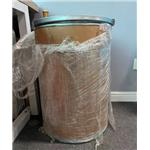 |
2024-03-12 | Probenecid
57-66-9
|
US $0.00 / kg | 25kg | 98% HPLC | 10tons | shandong perfect biotechnology co.ltd | |
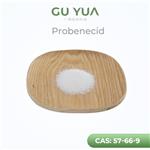 |
2024-03-08 | Probenecid
57-66-9
|
US $10.00 / kg | 1kg | 99% | 1000kg | Nantong Guangyuan Chemicl Co,Ltd | |
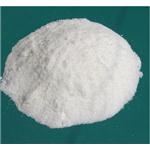 |
2024-01-02 | Probenecid
57-66-9
|
US $99.00 / KG | 1KG | 0.99 | 15T | Zibo Hangyu Biotechnology Development Co., Ltd |
-

- Probenecid
57-66-9
- US $0.00 / kg
- 98% HPLC
- shandong perfect biotechnology co.ltd
-

- Probenecid
57-66-9
- US $10.00 / kg
- 99%
- Nantong Guangyuan Chemicl Co,Ltd
-

- Probenecid
57-66-9
- US $99.00 / KG
- 0.99
- Zibo Hangyu Biotechnology Development Co., Ltd
57-66-9(Probenecid)Related Search:
1of4





